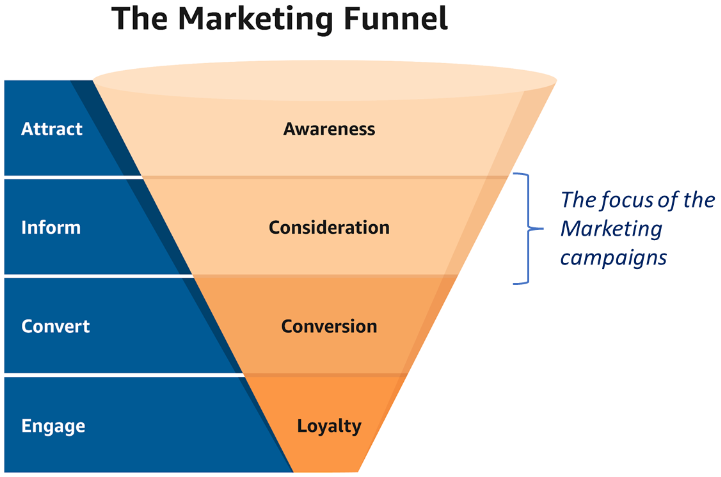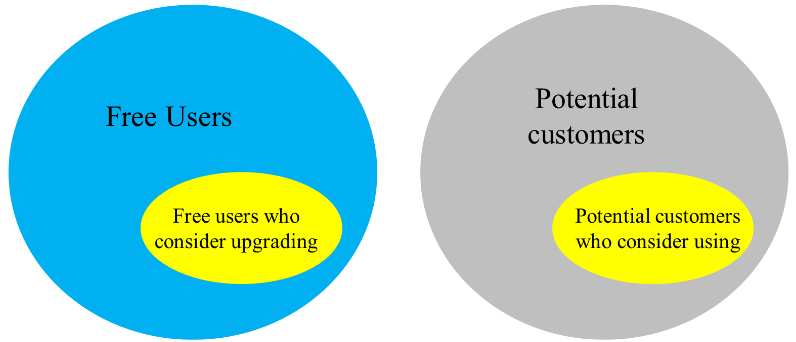Marketing campaigns are run to build upon the awareness created by the brand campaigns. They connect your products to your customers. The broader goal of the marketing campaign success is to push the customers down the marketing funnel and define the strategies to drive sales and revenue.
No, they do not directly drive sales.
They help construct a long-term marketing strategy.
What is a marketing campaign?
Say you are the owner of this freemium app that is free to use with limited features and has a premium version that unlocks certain features for the users by purchasing a monthly or an annual subscription. For such an app, the target audience for the marketing campaigns is the users in the free version and not the paid users. Through the help of marketing campaigns, you want to ensure a seamless experience for the users, which motivates the users to consider purchasing your premium product. You are not trying to convert these users to your premium offerings but just want to move the consideration metric through the marketing campaigns. In a marketing funnel, they focus on the consideration section.

Now that we know what a marketing campaign is, let’s get to the point.
How do you run a marketing campaign successfully?
A lot goes into the planning of a marketing campaign. From marketing strategy to creative ideas to finally launching the campaign, there are ‘n’ steps. But only five steps are crucial to ensure your marketing campaigns are successful.
Define success metric
When you talk about success, the first step is to define it. The good thing is that you already know that the metric or the KPI you want to see a shift from the marketing campaigns is the consideration.
But do you know the drivers of consideration?
You should know that the users will only consider upgrading from free to premium when they enjoy your product experience. These users are more engaged, aware of your app’s different features, ready to adapt to new features and invite more users to your app. Identify which of these you think is the driver of your consideration and want to focus through your campaign. This driver metric becomes your success metric and helps you know the purpose of your marketing campaign.
Identify your target audience
The most common way to define consideration is the percentage of free users who consider using the premium features.

Another way to define consideration is the fraction of your potential customers who are aware of your app that considers using your product.
The earlier definition of consideration applies to the internal users, and the latter applies to the potential external customers. The second step to successfully running a marketing campaign is identifying your target audience. They can be your internal or external customers. They can fall into any age, region, or user type segment.
Select your marketing channels
Once you have defined your success metric, the purpose of the campaign, and the target audience, the next step is to select your marketing channels. Not just the above factors, we are also interested in knowing what channels worked for you in the past to define your marketing channels. Some channels are push, emails, in-app messaging, social media platforms, etc. Running the campaigns on all these channels wouldn’t be a good idea because of the high cost. Hence, analysis of the campaign performance by channel helps identify the top X channels that you can use for our future campaigns.
A/B testing
Apart from the above, a lot goes into the campaign planning, like generating ideas for the campaign, campaign creatives, and estimating the resources and the budget. This means a considerable investment of time and money. On top of that, you never know whether your campaign will be successful. This is where experimentation comes to the rescue.
Say you want to improve the app engagement, and you have three campaign ideas but are unsure whether they will improve engagement or cause a churn. You want to know which idea is better. In such cases, it is best to test the idea using A/B testing.
In A/B testing, you create control and test groups with a sample of the user population. There will be three test groups for each of the three campaigns. Now, you will run the campaigns for the test group and compare the app engagement in the test groups against the control group. Along with the increase in app engagement, you should also keep an eye on churn, which is the secondary metric. The campaign that sees the maximum increase in the app engagement while keeping the churn the same or less is the campaign idea you should choose for rolling out with the larger user population.
This way, you can test your campaign ideas to see which is the best. You can perform a similar test to compare different marketing channels, or test multiple campaign ideas along with several marketing channels through multivariate testing. To learn more about experiments, refer to the blog on how to run experiments successfully.
Mid-campaign and post-campaign analysis
Even after doing all the campaign planning and finally launching the campaign, the project doesn’t end. Without the campaign analysis, You will not know your campaign’s short-term and long-term impact. To realize the full potential of your campaigns, it is vital to do a campaign analysis. A mid-campaign analysis helps you know whether the campaigns are running as expected or if you need to tweak them. For example, through mid-campaign analysis, you realize that certain channels outperform others, then you would want to adjust your channel budgets accordingly. On the other hand, a post-campaign analysis helps measure the campaign‘s effectiveness through the lift in the success metric.
The success metric of a marketing campaign is just a driver; the goal is to track the KPI of the marketing campaign.
Consideration – the KPI for marketing campaigns
The success metrics, like app engagement, feature awareness, usage, adoption, and marketing engagement, act as a proxy for consideration. But it may not always give you a complete picture. You need to measure consideration explicitly.
Like awareness, you cannot directly track consideration through the campaign data. For external customers, you can measure it through external surveys, say, brand awareness surveys. For internal customers, you can measure it through in-app surveys. The in-app surveys also help you know which product features they like or dislike, how likely they will recommend your product, and what prevents/motivates them to upgrade to your premium offerings. The answers to these qualitative questions help determine what the users think about your product and can provide great insights for your marketing and product teams.
Conclusion
The marketing campaigns connect your products to your customers. They create awareness about your product, its features, and its benefits. Hence, it is essential to run them successfully. The five crucial steps to a successful marketing campaign are defining the success metric, identifying the target audience, selecting proper marketing channels, A/B testing, and conducting campaign analysis.
While running these campaigns and measuring their success, do not lose sight of the marketing campaign’s goal, i.e., consideration. The marketing campaigns drive consideration pushing the users down the marketing funnel and bringing them closer to revenue and profits. The following post will cover the campaigns that drive growth. Until then, Happy Marketing!


[…] 1. Marketing Campaigns […]
[…] neither brand nor marketing campaigns convert your potential customers or users to paying ones. This is done through advertising […]